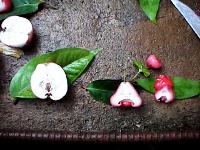


The following fruit is commonly referred to as a Pohnpei apple:



The site http://www.cdfa.ca.gov/plant/agidaid/page54.htm provides an image of a fruit with the bell shape of the "Pohnpei" apple and calls this fruit Syzygium malaccensis. This same site provides the following description: "Bell-shaped, about 2 inches long, skin yellow-red to red when ripe, white flesh." with the following common names: "Mountain apple, Malay apple, Malay rose apple, Jambu merah, Pomerac jambos."
The following fruit is referred to by Kosraen's as a Kosraen apple:




Note that "Kosrae" apple is considered to be a better eating apple locally, it is bigger, fleshier, and sweeter.
"Syzygium malaccense... the four red petals fall early to expse the numerous, showy red stamens 1-2 cm long. The flesh, glossy red to white, obovoid fruit is motly 3-7 cm long and contains a single large seed." Tongan Herbal Medicine, W. Arthur Whistler.
Another site, http://www.batcon.org/ffecon4.html , distinguishes between Syzygium malaccense and Syzygium samarangense by noting that S. malaccense "Fruit eaten and is juicy but tasteless." while S. samarangense "Fruit eaten and is better than other species in genus for this purpose." This might be taken as evidence that the less tasty Pohnpei apple is indeed S. malaccense while the Kosrae apple is S. samarangense. This site also describes Syzygium jambos with the phrase, "Fruit eaten fresh ("jambu" or Rose apple); popular local fruit." No image is provided.
The site
http://www.carambolafly.com/annual96.html , only adds the following information:
Syzygium cuminii 'djamoen'
Syzygium malaccensis malay apple
Syzygium samarangense java apple
The site http://www.xc.org/echo/onplanta.htm also adds only naming information, calling Syzygium cumini the Jambolan or Java Plum and Syzygium samarangense the Wax Jambu. Both of the local apples have a very waxy appearance.
The University of Hawaii at http://www.botany.hawaii.edu/faculty/carr/myrt.htm adds a high quality picture of flower of Syzygium jambos, calling it a "rose apple" and the information that "This is a large tree with edible fruit. Note the very dominant nature of the androecium in the open flower." UH also has images of Syzygium cumini noting that this is also known as the "Java plum, jambolan plum" and is a "tree from E. Indies and Burma, with white flowers and purple to black, globose, edible fruit." Neither of these appear to match, as far as I can tell from the images, our local apple types.
The site http://zoneten.com/nurseryplants.htm really complicates matters as it has pictures of a fruit that appear to be identical to the "Pohnpei apple" and it is labelled as being a Wax Jambu. Bear in mind that up until now the "tastier" fruit, Syzygium samarangense, has been termed the Wax Jambu. That Syzygium samarangense is likely the Wax Jambu (while S. malaccense is something like a Jambu merah) is in part backed up by a picture at http://www.tropicalfruittrees.com/w.htm labelled "Wax jambu." I say in part because the image is slightly more bell shaped than our "Kosrae" apple but is definitely not (based on the seed location) our "Pohnpei" apple. Another site, http://www.proscitech.com.au/trop/link.htm , also backs up calling the rounder fruit S. samarangense. This site also labels the fruit as being a Wax jambu. This site indicates that the flowers of S. samarangense are red. Remember: the "Pohnpei" apple has white flowers, making it distinctive in both flower and fruit shape from the "Kosrae" apple with its red flowers. This site also names a number of other species:
Syzygium aqaeum - bell fruit
S. cumini - jambolan
S. jambos - roseapple
S. malaccense - Malay apple
S. pycnanthum - wild rose apple
S. samarangense - wax jambu
A picture of S. aqaeum is provided, the image is of small, red, bell shaped fruits that appear slightly more flattened top to bottom than the Pohnpei apple.
A third fruit, referred to as "appel en katik," or "sour apple" looks like the "Pohnpei apple" but is smaller in size.

When placed in the same shot, the three apples appear as seen below:

Left to right: "Kosrae apple" "Pohnpei apple" "Sour apple." Each is sitting on its own leaf. Just to add to the fun, there is a fourth apple on island that is said to be smaller, rounder, and even more sour than the sour apple.
If anyone can shed any useful light on our confusion, feel free to drop Dana Lee Ling a line.
This page hosted by ![]() Get your own Free Home Page
Get your own Free Home Page